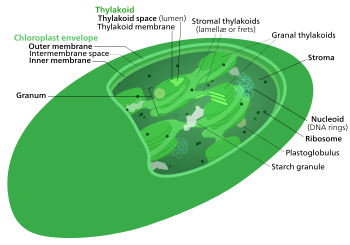Intermembrane space
.svg.png)

The intermembrane space (IMS) is the region between the inner membrane and the outer membrane of a mitochondrion or a chloroplast. The main function of mitochondrial intermembrane space is oxidative phosphorylation.
Channel proteins called porins in the outer membrane allow free movement of ions and small molecules into the intermembrane space. This does not mean that it is essentially continuous with the cytosol in terms of the solutes relevant for the functioning of these organelles. Enzymes destined for the mitochondrial matrix or the stroma can pass through the intermembrane space via transport through [1]s. These are known as translocase of the outer mitochondria membrane (TOM) and translocase of the inner mitochondrial membrane (TIM) in mitochondria and translocase of the outer chloroplast membrane (TOC) and translocase of the inner chloroplast membrane (TIC) in chloroplasts. It tends to have a low pH because of the proton gradient which results when protons are pumped from the mitochondrial matrix into the intermembrane space during electron transport. The structures responsible for this are coenzyme Q, NADH coenzyme Q oxidoreductase complex (complex I), succinate-coenzyme Q oxidoreductase complex (complex II), and coenzyme Q-cytochrome c oxidoreductase complex (complex III).
Intermembrane space of mitochondria
- Main article: Intermembrane space of mitochondria
Because of channels in the outer membrane of the mitochondria, the content of the intermembrane space is similar to that of the content of the cytoplasm. ATP consists of adenosine — composed of an adenine ring and a ribose sugar — and three phosphate groups (triphosphate)
Intermembrane space of chloroplast
The intermembrane space of the chloroplast is extremely small, somewhere from 10-20 nm thick. Unlike the intermembrane space of the mitochondria, the intermembrane space of the chloroplast does not seem to have any obvious function.